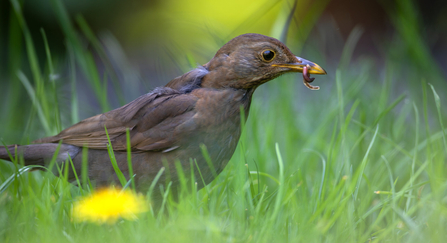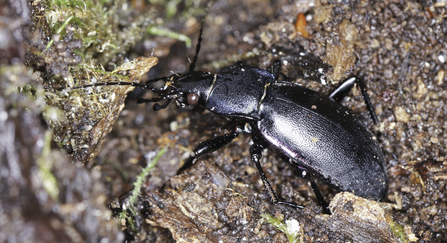We’re always fascinated by predators, and the dramatic battles for survival that take place every day in the animal kingdom. Documentaries show us prides of lions chasing buffalos across the Serengeti, or jaguars pouncing on caiman in the Pantanal. But we don’t have to turn to the television to see hunters in action. Every habitat has its predators and their prey, including our garden lawns – especially when we let them grow a little wilder. The scale may be smaller, but the stakes are just as high!
Birds
Birds are the most obvious predators prowling our lawns. You might have seen blackbirds hopping around the garden, searching for worms. When they spot one, they pounce, pluck it from the ground, and slurp it down like wriggly spaghetti. If they have chicks to feed, they might collect whole beakfuls of worms to carry back to their nest. Earthworms make up an important part of the diet of many birds, especially thrushes and robins. Tawny owls have even been spotted hunting them on lawns after wet weather.
It's not just worms that birds are seeking in our gardens’ grassy areas. They’ll snatch spiders and insects from taller patches and even dig creatures out of the soil. Starlings specialise in hunting leatherjackets – the larvae of craneflies, which burrow into lawns. They probe the soil with their beak, feeling around for their insect prey.

Blackbird © Jon Hawkins - Surrey Hills Photography
Beetles
Many insects are also predators in their own right. With more than 4,000 species of beetle in the UK, there are plenty you could find in your garden. One of the most familiar is the ladybird – though there are many different species of ladybird in the UK. Ladybirds are voracious predators. Both adults and larvae feed on aphids, which can be found on all manner of plants. If you’ve got a flower-filled patch of long grass in your lawn, there’s a good chance you’ll find ladybirds roaming in it.
Some predatory beetles are harder to spot. At just 2-3cm long, a violet ground beetle might not seem that fearsome, but to slugs, snails, and other invertebrates these beetles are bad news. They spend the day lurking under logs, beneath bark, or in the soil. At night they emerge to prowl around the garden, on the hunt.

Violet ground beetle © Frank Porch
Amphibians
We tend to think of amphibians like frogs, toads, and newts as pond creatures. Water is essential for their lifecycle, but as adults they spend a lot of their time on land. Patches of long grass provide them with both shelter and a hunting ground. The tall grass hides them from predators, as well as trapping moisture that helps prevent amphibians from drying out in warm weather. It’s a home with a well-stocked larder, as these conditions are also perfect for the worms, slugs, spiders, and insects they like to eat.

Smooth newt © Philip Precey
These are just a few of the predators that could be prowling your lawn. The wilder your lawn, the more life it’s likely to support. Try letting some patches grow longer, and allowing wildflowers to flourish even on the shorter sections.


